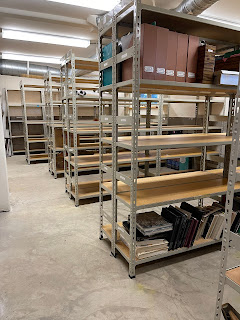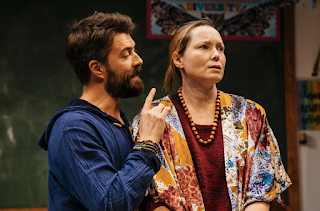What has changed since then?
For one thing, like everyone else who watches television we have noticed how many people of color are now featured in commercials. Then there is a television series started in 2016, “Lucifer”, where the hero from hell, i.e. the devil, (Tom Ellis) is played by a white individual, while his brother, an angel, (D.B. Woodside), is played by a black man. If you’ll excuse the expression, “what a contrast”. We find that these two disparate characters are underneath, extremely similar.
Quite rightly we are being acclimatized to equality of color and the sexes. As the younger generation who are still being molded into maturity, hopefully more will become both color blind and less sexist. It has been pointed out to me that there are now more female anchor people on television, albeit in the daytime and at night more male. It would seem that the networks are catering to their perceived audiences as to when more women or men watch the telly ...
The staid museums come a bit late to the party but slowly and surely they too are realizing their lack of inclusiveness. I learned something interesting after writing the Pareja Missive from Nancy Hoving, widow of the then Director of the Metropolitan Museum, Thomas Hoving. She wrote, “Looking at all the great painting and painters we see today I can't figure out where (TH) and I were. Kerry James Marshall and others were around but we never saw them. I can’t understand how this happened because I know (TH) would have liked him as much as I do. And there are others.” In 2015 the Met did finally buy a painting by the artist of his Studio. It was painted in 2014 and acquiered through the art dealer David Zwirner. The Met then followed up with a Marshall retrospective the year after.
Why? It would be easy to say that the museum curators were just not interested or was it that the name dealers who they relied on were not showing art by people of color. Of course, there were many below 57th street but that was a country away.
I also wonder whether it was thought of as appropriate that the art of the other be in a separate museum. Who knows? “They” had their own museum such as the Studio Museum in Harlem. From their website: “The Studio Museum in Harlem was founded in 1968 by a diverse group of artists, community activists and philanthropists who envisioned a new kind of museum that not only displays artwork but also supports artists and arts education.”
Another example of this concept one might call euphemistically, separate but equal is The Museum of the American Indian/Heye Foundation which was established by wealthy collector George Gustav Heye in 1908. Heye began collecting American Indian art as early as 1897. His collection rapidly increased over the next several years but was devoted to traditional tribal material. Only since it became the National Museum of the American Indian in 1989/96 did it expand its focus to contemporary work.
My father who started out his life as a strictly orthodox Jew and only became conservative after his son was born as he did not want him to be extreme in this democratic country. He did not support the Jewish Museum because he said there was no such thing as Jewish art. Art was art far as he was concerned. Maybe it is because of that last bit I too believe all art is equal and paintings are paintings, furniture is furniture and jewelry is jewelry, etc. and sometimes they may rise to the exulted heights of the current definition of art.
Art is a reflection of people and their life experience. Visitors to museums can ask how works of art by artists of different ethnicities relate to their life experience. What better way to teach than to show the different approaches that African American, Native American or Japanese Artists see the world or even similar subject matter?
Traditionally our encyclopedic museums turn out to be a series of separate fiefdoms each of which are separate but not equal. The galleries that get the most space are often the European Paintings and the Chinese art or African art are given less gallery space. You can mix those priorities in a different order for different museums but the attitude is that never the twain shall meet. You hear people visit just one section of a museum never being exposed to another. In my opinion the main galleries should have a mixture of cultures then you can have sections that specialize for those who wish to concentrate on a specific field. I am pleased to say that the Metropolitan Museum’s relatively new Director, Max Hollein is now encouraging curators to communicate with those in other departments to this end.
Just think of how thought provoking it would be to see the Anglo traditional image of Thanksgiving by Norman Rockwell and this one by Paula Peters, a member of the Mashpee Wampanoag tribe. Members of the tribe gathered near Plymouth Rock in 1991 for a day of mourning in response to the Pilgrims’ Thanksgiving.






















